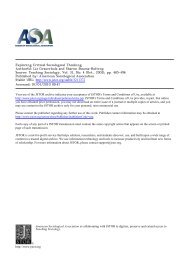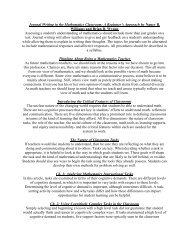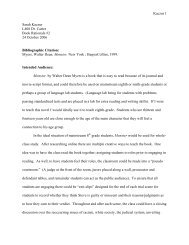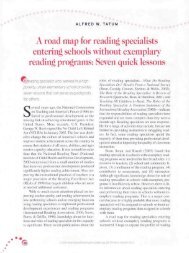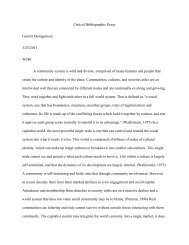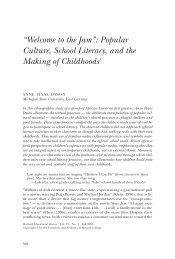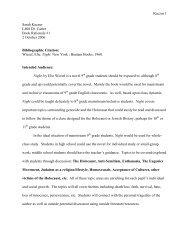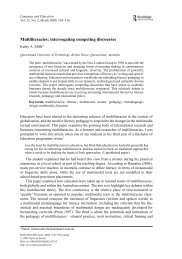Rose 2005 Pragmatics Synthesis.pdf - Oncourse
Rose 2005 Pragmatics Synthesis.pdf - Oncourse
Rose 2005 Pragmatics Synthesis.pdf - Oncourse
Create successful ePaper yourself
Turn your PDF publications into a flip-book with our unique Google optimized e-Paper software.
System 33 (<strong>2005</strong>) 385–399<br />
SYSTEM<br />
www.elsevier.com/locate/system<br />
On the effects of instruction in second<br />
language pragmatics<br />
Kenneth R. <strong>Rose</strong> *<br />
Department of English and Communication, City University of Hong Kong, Tat Chee Avenue,<br />
Kowloon, Hong Kong<br />
Received 4 February <strong>2005</strong>; received in revised form 18 March <strong>2005</strong>; accepted 20 April <strong>2005</strong><br />
Abstract<br />
Despite the fact that research on the effects of instruction in second language pragmatics is<br />
a subset of the literature on instructed second language acquisition, pragmatics as a learning<br />
target does not figure prominently in most surveys of this area. This is due partly to the fact<br />
that instructional effects research in second language acquisition has only recently come into<br />
its own and still has a long way to go [Norris, J., Ortega, L., 2000. Effectiveness of L2 instruction:<br />
a research synthesis and quantitative meta-analysis. Language Learning 50, 417–528], but<br />
also is the result of a relative neglect of pragmatics in second language acquisition in general.<br />
Nevertheless, arguments have been put forward for the necessity of instruction in pragmatics<br />
[Bardovi-Harlig, K., 2001. Evaluating the empirical evidence: grounds for instruction in pragmatics<br />
In: <strong>Rose</strong>, K.R., Kasper, G. (Eds.), <strong>Pragmatics</strong> in Language Teaching. Cambridge University<br />
Press, Cambridge, pp. 13–32], and there is now a growing body of research which<br />
addresses this issue [Kasper, G., <strong>Rose</strong>, K.R., 2002. Pragmatic development in a second language.<br />
Blackwell, Mahwah, NJ. (Also Language Learning: Supplement 1, 52)]. This paper will<br />
review the literature on the effects of instruction in second language pragmatics by first considering<br />
the learning targets, learner characteristics and learning contexts represented in the<br />
studies done to date. Following this, are three central issues which occupy much of the literature:<br />
the teachability of pragmatics, the relative benefits of instruction versus exposure, and<br />
whether different approaches to instruction yield different results.<br />
Ó <strong>2005</strong> Elsevier Ltd. All rights reserved.<br />
* Tel.: +852 2788 8883; fax: +852 2788 8894.<br />
E-mail address: ken.rose@cityu.edu.hk.<br />
0346-251X/$ - see front matter Ó <strong>2005</strong> Elsevier Ltd. All rights reserved.<br />
doi:10.1016/j.system.<strong>2005</strong>.06.003
386 K.R. <strong>Rose</strong> / System 33 (<strong>2005</strong>) 385–399<br />
Keywords: <strong>Pragmatics</strong>; Politeness; Communicative language teaching; English as a second language instruction<br />
1. Introduction<br />
This paper examines what research on pedagogical intervention has to say about<br />
the effects of different instructional strategies for second language pragmatic learning.<br />
The rationale for examining the effects of instruction in pragmatics is underscored<br />
by SchmidtÕs (1993) contention that simple exposure to the target language<br />
is insufficient – pragmatic functions and relevant contextual factors are often not<br />
salient to learners and so not likely to be noticed even after prolonged exposure. Furthermore,<br />
Bardovi-Harlig (2001) makes a strong case for the necessity of instruction,<br />
documenting that second language learners who do not receive instruction in pragmatics<br />
differ significantly from native speakers in their pragmatic production and<br />
perception in the target language. I will first discuss the learning targets, learner characteristics,<br />
and learning contexts represented in the small, but growing body of research<br />
on the effects of instruction in second language pragmatics. Following this,<br />
I turn to three central questions relating to the effect of instruction on pragmatics:<br />
whether pragmatics is teachable, whether instruction in pragmatics produces results<br />
that outpace exposure alone, and whether different instructional approaches yield<br />
different outcomes.<br />
2. Learning targets<br />
A wide range of discoursal, pragmatic, and sociolinguistic targets of instruction<br />
have been the object of research on the effectiveness of instruction in pragmatics.<br />
These include discourse markers and strategies, pragmatic routines, speech acts,<br />
overall discourse characteristics, and pragmatic comprehension.<br />
Among the studies that have examined the effects of instruction on discourse<br />
markers and strategies are Wildner-BassettÕs (1984, 1986) work on gambits in English<br />
and YoshimiÕs (2001) study of Japanese interactional discourse markers. Wildner-Bassett<br />
selected as the object of instruction formulas and conversational<br />
routines for speech acts such as expressions of (dis)agreement and requests. Yoshimi<br />
(2001) focused on the Japanese discourse markers n desu, n desu ne, and n desu kedo,<br />
all of which ‘‘play important roles in organizing the presentation of an extended telling,<br />
and in expressing the speakerÕs interpersonal orientation in such a telling’’<br />
(p. 224). The various functions of these three interactional markers represent a range<br />
of important, and often subtle, aspects of the pragmatics of Japanese oral narratives.<br />
Pragmatic routines represented in the literature include the various functions of Japanese<br />
sumimasen in Tateyama et al. (1997) and Tateyama (2001), as well as hedging<br />
in academic writing and computer-mediated discourse in Wishnoff (2000). In the
K.R. <strong>Rose</strong> / System 33 (<strong>2005</strong>) 385–399 387<br />
Tateyama studies, beginning learners of Japanese were taught the range of discoursepragmatic<br />
functions realized by the routine formula sumimasen, such as getting<br />
attention, apologizing, and expressing gratitude. WishnoffÕs participants were far<br />
more advanced than TateyamaÕs learners of Japanese, thus allowing WishnoffÕs<br />
instructional goals to involve the rather complex area of hedging expressions in academic<br />
writing. These included conditional statements (e.g., could), modifiers (e.g.,<br />
usually, some), framing statements (e.g., even though, I would argue), verb choice<br />
(e.g., it seems to me, it depends), and quantifiers (e.g., some, many).<br />
Several studies have focused on specific speech acts and their realization strategies.<br />
Such studies include Olshtain and Cohen (1990) on apologies. Their study<br />
was designed to move past the more basic apology forms, and instead include a<br />
wider range of semantic formulas used in apologies, such as explanation, offer of repair<br />
and promise of forbearance. Billmyer (1990a,b) and <strong>Rose</strong> and Ng (2001) have<br />
taken up compliments and compliment responses as the object of instruction. Manes<br />
and WolfsonÕs (1981) research on compliments has served as the main source of<br />
instructional content for these studies by providing the nine so-called Ôsyntactic formulasÕ<br />
for compliments, the top three of which (e.g., That dress is really nice, I really<br />
love that dress, ThatÕs really a nice dress) accounted for some 85% of compliments in<br />
their corpus. For compliment responses, learners in both studies were taught the<br />
range of compliment response types (i.e., accept, deflect, and reject), and also made<br />
aware of the interactional utility of deflection as a preferred strategy. Requests have<br />
also served as the learning target in several studies. In the case of Fukuya and Clark<br />
(2001), the focus was on six mitigators (i.e., perhaps, possibly, IÕd be grateful if, IÕd<br />
appreciate if, I was wondering if, and I know ... but) used to soften the impositional<br />
force of requests. For Takahashi (2001, this issue), the target was instead two biclausal<br />
English request forms (i.e., Would/could you VP and Would it be possible to VP).<br />
TakahashiÕs previous work had demonstrated that Japanese learners of English were<br />
unable to determine the proper functional equivalents for these requests forms in<br />
Japanese, which indicates lack of pragmalinguistic knowledge on their part concerning<br />
one of the ways in which request imposition can be mitigated in English. Safont<br />
(2003) and Salazar (2003) both examined the effects of instruction in English requests<br />
with Spanish-speaking university students in Spain. In Safont’s (2003) study, request<br />
modification (e.g., softeners, grounders, disarmers) was the focus, and learners evidenced<br />
a marked increase in their use of internal and external modification on a written<br />
discourse-completion task (DCT) posttest, but in the case of Salazar (2003)<br />
learners showed no difference in the range of request strategies on the DCT preand<br />
posttest, despite having evidenced use of a wider range of strategies during<br />
one of the instructional sessions. Suggestions have also been addressed in interventional<br />
studies such as the studies conducted by Martínez-Flor and Fukuya (this issue)<br />
and Koike and Pearson (this issue).<br />
A smaller body of research has examined instruction in overall discourse characteristics.<br />
This includes LysterÕs (1994) study on the effects of instruction on socio-stylistic<br />
variation in French, HouseÕs (1996) work on pragmatic fluency in English, and<br />
Liddicoat and CrozetÕs (2001) study on the Ôgood weekendÕ question in French.<br />
Lyster focused on the contextually appropriate use of the French pronouns tu and
388 K.R. <strong>Rose</strong> / System 33 (<strong>2005</strong>) 385–399<br />
vous, the latter of which is preferred in more formal contexts – an apparently difficult<br />
point for his Grade 8 French immersion students in Canada. House (1996) set rather<br />
more ambitious learning targets, which included gambits (e.g., uptakers, clarifiers,<br />
appealers, and starters), discourse strategies (e.g., grounders, disarmers, topic introducers),<br />
and speech acts (e.g., greeting, leave-taking). House (1996) notes that hers<br />
were ‘‘very advanced German university students of English’’ (p. 229), which would<br />
appear to account for such challenging material. For Liddicoat and CrozetÕs (2001)<br />
second-year French students, the learning target was interactionally appropriate responses<br />
to the French question TÕas passé un bon week-end (ÔDid you have a good<br />
weekendÕ), which should be elaborated and not formulaic, and should invoke indicators<br />
of attentive listener behavior.<br />
Whereas most studies have concentrated on the production of the target features<br />
or their use in interaction, instruction specifically aimed at improving learnersÕ pragmatic<br />
comprehension has received far less attention. Exceptions are studies on English<br />
as a second language (ESL) learnersÕ comprehension of implicatures in indirect<br />
responses by Bouton (1994a) and Kubota (1995). In both studies, learners were exposed<br />
to a range of implicature types, including the Pope-Q implicature. The infamous<br />
Pope-question (Is the Pope Catholic) in response to another question<br />
generates the implicature that the answer to the question is both obvious and affirmative.<br />
The Pope-Q implicature can also take a negative form, as this Cantonese<br />
example (translated here to English) shows: Is your mother a man More research<br />
is needed on pragmatic comprehension. To date, then, the literature indicates that<br />
a wide range of discoursal, pragmatic, and sociolinguistic features have been targeted<br />
for instruction.<br />
3. Learner characteristics and learning contexts<br />
The scope of learner characteristics represented in studies on the effectiveness of<br />
instruction in second language pragmatics is rather smaller than the range of learning<br />
targets. These include learnersÕ first language, the target language, age, proficiency,<br />
educational context, and the status of the target language in the wider<br />
community.<br />
In terms of learnersÕ first languages, English (Liddicoat and Crozet, 2001; Lyster,<br />
1994; Tateyama, 2001; Tateyama et al., 1997; Yoshimi, 2001) and Japanese (Billmyer,<br />
1990a,b; Fukuya and Clark, 2001; Kubota, 1995; LoCastro, 1997; Takahashi,<br />
2001, this issue) are equally represented. There are also studies involving native<br />
speakers of Cantonese (<strong>Rose</strong> and Ng, 2001), German (House, 1996; Wildner-Bassett,<br />
1984, 1986), Hebrew (Olshtain and Cohen, 1990), and Spanish (Alcón, this issue;<br />
Martínez-Flor and Fukuya, this issue; Safont, 2003; Salazar, 2003), with other studies<br />
drawing on mixed-language groups (Bouton, 1994a; Wishnoff, 2000). Reflecting<br />
the dominance of English as a target language in second language classroom-based<br />
research generally, by a wide margin English has been the most frequently chosen<br />
target language in studies on instruction in pragmatics. The only other target languages<br />
represented at the time of writing are Japanese (Tateyama, 2001; Tateyama
K.R. <strong>Rose</strong> / System 33 (<strong>2005</strong>) 385–399 389<br />
et al., 1997; Yoshimi, 2001) and French (Liddicoat and Crozet, 2001; Lyster, 1994).<br />
In terms of first- and second-language pairs, the English–Japanese pairing counts for<br />
about half of the studies. Future research needs to expand the range of first language<br />
and target languages, not least in order to enable investigators and language educators<br />
to better assess whether and to what extent findings from studies of a particular<br />
first language or target language may be transferable to other language pairings.<br />
Another learner characteristic for which there is little variation across studies is<br />
age – with the exception of Lyster (1994), whose participants were adolescents, all<br />
of the interventional studies to date have involved adult language learners. Because<br />
younger learners may require different instructional measures to support their learning<br />
of second language pragmatics, and it is not clear whether child learners in a second<br />
language context even require organized instructional intervention (Schmidt,<br />
1993), interventional classroom research for this age group is urgently needed.<br />
More information is available on the role of overall second language proficiency<br />
in instructed learning of pragmatics. TateyamaÕs studies (Tateyama, 2001; Tateyama<br />
et al., 1997) demonstrate that short pragmatic routines are teachable to absolute<br />
beginners, as does SafontÕs (2003) work on request modification, indicating that<br />
pragmatics can be learned before students begin to develop analyzed second language<br />
knowledge. At the other end of the spectrum is the question of whether<br />
instruction is necessary – or at least facilitative – for learners of more advanced levels<br />
of proficiency. It appears that pragmatic practices which are difficult for advanced<br />
learners to acquire without instruction are in fact learnable through interventional<br />
measures (Bouton, 1994a; House, 1996; Olshtain and Cohen, 1990). The majority<br />
of studies have included learners of intermediate proficiency, and these studies have<br />
also produced the most mixed results. In some studies, students clearly profited from<br />
the instruction provided (Billmyer, 1990a,b; Wildner-Bassett, 1984), while in others<br />
only one of several treatments made a difference (Takahashi, 2001), pre- and posttest<br />
differences were found on only a few of several measures (<strong>Rose</strong> and Ng,<br />
2001), initial gains had disappeared by the time of a delayed post-test (Kubota,<br />
1995), or no differences were found between treatment and control groups (Fukuya<br />
and Clark, 2001). However, it is doubtful that the small or absent treatment effects<br />
derived solely from participantsÕ proficiency – studentsÕ educational background and<br />
issues of research design and procedures appear to have contributed to these<br />
outcomes.<br />
The rather narrow range of learner characteristics is paralleled by the educational<br />
contexts in which the interventional studies have been conducted. With two exceptions<br />
– LysterÕs (1994) study in a secondary school, and Wildner-BassettÕs (1984,<br />
1986) work in a business context – all studies that I am aware of were carried out<br />
in universities. More research set in other educational contexts is clearly needed<br />
(see for instance AlcónÕs study in this issue for a study conducted in a secondary education<br />
context). Concerning the status of the target language in the surrounding<br />
community, it is noteworthy that the majority of studies were conducted in a foreign<br />
language rather than a second language environment, that is, in contexts where students<br />
had little benefit of second language input and interaction outside the<br />
classroom.
390 K.R. <strong>Rose</strong> / System 33 (<strong>2005</strong>) 385–399<br />
4. Research issues and findings<br />
Studies on the effect of instruction in pragmatics seek to answer three basic questions:<br />
first, is the targeted pragmatic feature teachable at all Second, is instruction in<br />
the targeted feature more effective than no instruction And third, are different teaching<br />
approaches differentially effective The first question, whether pragmatics are<br />
amenable to instruction at all, is the most basic of the three questions, representing<br />
at best a starting point analogous to LongÕs (1983) early survey of instructed second<br />
language acquisition research which attempted to answer the question Does second<br />
language instruction make a difference Question two – the comparison of the relative<br />
merits of instruction versus simple exposure – echoes Norris and OrtegaÕs (2000) first<br />
research question, reflecting the fact that this is the point where things begin to get<br />
more interesting. Knowing whether a given feature is teachable is one thing, but<br />
knowing whether instruction is more effective than exposure is another. The third<br />
question further specifies the issue by addressing the differential effects of more than<br />
one type of instructional intervention. Studies which fall into the third category are<br />
likely to yield information that is most relevant for pedagogical purposes.<br />
4.1. Teachability<br />
The most basic question that studies on the effect of instruction in pragmatics may<br />
consider is whether a particular area of pragmatics is at all teachable. Such studies<br />
typically adopt a one-group pretest–posttest design. Olshtain and Cohen (1990)<br />
chose as their learning target the more subtle aspects of apologizing, such as the differences<br />
between excuse me and IÕm sorry, and the effects of context on the choice of<br />
intensifiers. LoCastroÕs (1997) pedagogical intervention dealt with politeness strategies<br />
in group discussion, such as requesting answers, directing the talk, and seeking<br />
(dis)agreement, whereas Liddicoat and Crozet (2001) set out to teach appropriately<br />
elaborated responses to the French question TÕas passé un bon week-end (Did you<br />
have a good weekend). Two studies done with university students learning English<br />
in Spain by Safont (2003) and Salazar (2003) both dealt with the effects of instruction<br />
on requests, with the former focusing on the use of internal and external modification.<br />
In these studies, treatment lengths varied from a minimum of two (Salazar,<br />
2003) or three (Olshtain and Cohen, 1990) 20-min sessions to a maximum of instruction<br />
spread out over a 9-week period (LoCastro, 1997). Assessment measures also<br />
varied considerably, from written DCTs (Olshtain and Cohen, 1990; Safont, 2003;<br />
Salazar, 2003) to role-plays (Liddicoat and Crozet, 2001) and observations of small<br />
group interaction (LoCastro, 1997). The type of instruction adopted in these studies<br />
could be characterized as explicit, which, according to DeKeyser (1995), requires<br />
that metalinguistic generalization be part of the instruction, whether it is provided<br />
by the teacher or the learners themselves. Results provided by teachability studies<br />
have been mixed. LoCastro (1997) found no change after 9 weeks of instruction –<br />
participants continued to rely on bare head acts at the time of the posttest. Olshtain<br />
and CohenÕs (1990) participants did not benefit from instruction in terms of overall<br />
frequency of semantic formulas used, but posttest responses did contain a wider
K.R. <strong>Rose</strong> / System 33 (<strong>2005</strong>) 385–399 391<br />
variety of apology strategies and an increased use of intensifiers compared to the pretest,<br />
indicating some benefit from the pragmalinguistic aspects of the instruction. Results<br />
of the first posttest conducted by Liddicoat and Crozet (2001) showed that the<br />
instruction had a greater impact on the overall content of the responses than on use<br />
of appropriate interactive devices such as feedback and repetition – for the interactive<br />
devices (what they refer to as ÔformÕ) the instruction had little impact. Results<br />
from a delayed posttest one year after the instructional period showed that learners<br />
retained most of the content features, but the only interactional practice they performed<br />
was feedback. Safont (2003) found that her participants evidenced a marked<br />
increase in the use of request modification on the posttest, but SalazarÕs (2003) participants<br />
showed very short-lived effects from the instruction during a treatment session<br />
– by the time of the posttest, these effects had disappeared.<br />
What accounts for these findings One issue to consider is whether outcome measures<br />
influence observed instructional effectiveness. In the case of LoCastroÕs (1997)<br />
study, there is reason to believe that her pretest/posttest measures may have contributed<br />
to the lack of instructional effects, despite a relatively lengthy instructional period.<br />
She relied on transcripts of a single group discussion conducted in a reading<br />
class to determine whether individual learners had benefited from instruction on<br />
politeness strategies provided in a speaking class. If it was her goal to assess learnersÕ<br />
ability to use these strategies in interaction, more than a single observation would<br />
have been advisable because it is possible that participants lacked ample opportunity<br />
to demonstrate what they might have learned in a single session. If the aim was to<br />
assess learnersÕ knowledge of the strategies, some sort of individual measure would<br />
have done the trick. It is entirely possible, then, that learners benefited from the<br />
instruction but this did not register on a single occasion of small-group interaction<br />
in a classroom context. A second issue has to do with quantity, and the related difficulty<br />
of the subject matter – was enough instruction provided to reasonably expect<br />
results for the particular learning target For instance, Salazar (2003) provided a<br />
mere 40 min of instruction – or even less because the first of her two 20 min sessions<br />
was used to administer the pretest. This can hardly be considered sufficient for mastering<br />
a range of request strategies. On the other hand, the partial success of the studies<br />
by Olshtain and Cohen (1990) and Liddicoat and Crozet (2001) also poses<br />
interesting theoretical problems. For Olshtain and Cohen, the problem appears to<br />
have been that instruction was not effective in equipping learners to deal with tasks<br />
for which some knowledge of sociopragmatics was required. That is, learners were<br />
presented with contexts together with a range of possible apology strategies, and<br />
asked to indicate whether they considered the various apologies ÔacceptableÕ, Ômore<br />
or less acceptableÕ or Ônot acceptableÕ. The fact that learnersÕ ratings did not change<br />
as a result of instruction, and remained different from those of native speakers, indicates<br />
a lack of sociopragmatic knowledge on their part. Olshtain and Cohen maintain<br />
that this is a simple exposure issue, and that a long length of residence is the<br />
solution. But exposure alone does not account for gains in pragmatic ability. Bouton<br />
(1994b) has demonstrated that some aspects of pragmatics do become (more or less)<br />
native like over time, but Bardovi-Harlig (2001) points out that even after lengthy<br />
periods of residence in the target language context, pragmatic infelicities can remain.
392 K.R. <strong>Rose</strong> / System 33 (<strong>2005</strong>) 385–399<br />
Overall, however, the research provides ample evidence demonstrating the teachability<br />
of pragmatic features. But is instruction more effective than simple exposure<br />
4.2. Instruction versus exposure<br />
Instruction versus exposure studies address the issue of whether pedagogical intervention<br />
in pragmatics leads to more effective learning than no instruction, or put another<br />
way, whether instruction is better than simple exposure. These studies provide<br />
a direct means of testing SchmidtÕs (1993) noticing hypothesis: the extent to which<br />
instruction which serves to draw learnersÕ attention to the targeted features proves<br />
to be more beneficial than simple exposure to the target language is the degree to<br />
which the noticing hypothesis is supported. As with the previous group of studies,<br />
instruction in each of the studies in this group could be characterized as explicit.<br />
A wide range of learning targets is represented in this group. BillmyerÕs (1990a,b)<br />
study on the effects of instruction on compliments and compliment responses was<br />
among the earliest interventional studies. Bouton (1994a) selected the understanding<br />
of implicature as his learning target, while Lyster (1994) examined the use of French<br />
tu/vous in informal and formal contexts. Wishnoff (2000) investigated the effects of<br />
instruction in the use of hedging devices (e.g., verb choice, quantifiers, modifiers,<br />
and conditional statements) in both formal and informal texts, and YoshimiÕs<br />
(2001) study focused on the Japanese interactional markers (n desu, n desu kedo, n<br />
desu ne) which feature prominently in the production of oral narratives. The range<br />
of instructional periods is also rather wide, with WishnoffÕs two class sessions (a total<br />
of one-and-a-half hours) on one end, and YoshimiÕs 24 h of instruction spread over<br />
an entire semester at the other. Assessment procedures included multiple choice tests<br />
(Bouton, 1994a; Lyster, 1994), and production tasks that were oral (Lyster, 1994)<br />
and written (Lyster, 1994; Wishnoff, 2000; Yoshimi, 2001). Only Billmyer<br />
(1990a,b) used as a measure of instructional effects learner production in actual<br />
face-to-face interaction. It is also worth noting that only Lyster (1994) employed<br />
more than one outcome measure.<br />
Without exception, learners receiving instruction in pragmatics outperformed those<br />
who did not. BillmyerÕs (1990a,b) instructed group outperformed the controls for frequency<br />
of compliments, norm-appropriate use, spontaneity, and adjectival repertoire,<br />
and favored the response strategy of deflection as they were taught, while the control<br />
group favored acceptance. In BoutonÕs (1994a) study, the experimental group achieved<br />
results as high as those observed with previous immersion students who had spent four<br />
years living in the US, but there was no such improvement for the control group.<br />
LysterÕs (1994) experimental participants outperformed uninstructed learners on all<br />
tasks except informal oral production, for which all learners used tu appropriately.<br />
These differences remained at the time of the delayed posttest. In the case of Wishnoff<br />
(2000), while use of hedges increased for both groups, the treatment groupÕs hedging<br />
devices increased more than 5-fold – a statistically significant difference across groups.<br />
And YoshimiÕs (2001) instructed learners showed a dramatic increase in frequency of<br />
interactional markers, but no similar increase in their use by the control group was observed.<br />
Although in these studies instruction proved superior to exposure, exposure
alone appears to have had some effect. In both BillmyerÕs (1990a,b) and WishnoffÕs<br />
(2000) studies, learners in the control groups registered noticeable improvement in<br />
the features targeted in the treatment provided to the experimental groups. Both studies<br />
dealt with subject matter that was of direct and immediate relevance to learners, and<br />
more importantly, concerned pragmatic features that learners in both groups were<br />
called upon to deploy in actual communicative use of the target language outside the<br />
classroom – a likely explanation for why learners in the control group improved despite<br />
a lack of targeted pedagogical intervention. Needless to say, a similar effect would not<br />
be observed in a foreign language context.<br />
An issue related to the success of instruction is the question of why certain features<br />
proved resistant to improvement. For example, Wishnoff (2000) found that despite<br />
the greater frequency of hedging devices used by learners in her experimental<br />
group, there were no significant changes in the variety of hedges they used on the<br />
pretest and the posttest. The greater frequency of the targeted pragmatic category<br />
with concomitant stability in the variety of strategies used is analogous to Olshtain<br />
and CohenÕs (1990) findings for apologies discussed above. Both studies also provided<br />
a rather limited amount of instruction. Yoshimi (2001) noted that not all<br />
the targeted features were learned equally well, and even her experimental learners<br />
evidenced considerable failure to use the target forms during communicative practice<br />
sessions, especially where more subtle aspects of the internal structure of tellings<br />
were concerned such as marking shifts in scene or perspective to highlight the point<br />
of a story, a result not unlike that of Liddicoat and Crozet (2001) discussed above. In<br />
both cases, learners receiving instruction had difficulty in mastering the more subtle<br />
aspects of the target features. In this case, it seems appropriate to appeal to BialystokÕs<br />
(1993) contention that due to limitations in the control of processing, adult<br />
learners may be unable to attend to the more subtle aspects of talk-in-interaction.<br />
In fact, Liddicoat and Crozet (2001) make such an argument, noting that their content<br />
features are more amenable to conscious attention and manipulation than their<br />
features of form, which are unconscious and automatic, making the latter a more difficult<br />
instructional target. Nevertheless, it appears that instruction outpaces exposure<br />
alone in the learning of second language pragmatics. What about the effects of different<br />
types of instruction<br />
4.3. Different teaching approaches<br />
K.R. <strong>Rose</strong> / System 33 (<strong>2005</strong>) 385–399 393<br />
Most studies comparing the effectiveness of different teaching approaches select<br />
two types of pedagogical intervention, and in all cases the intervention could be construed<br />
as explicit versus implicit. One could argue that these studies have much in<br />
common with those examining the effect of instruction versus no-instruction discussed<br />
in the previous section, with a crucial difference being that while studies in<br />
the second group compared instruction to exposure which was not manipulated to<br />
ensure that it contained the target features, studies in this group involved two (or<br />
more) treatments which guaranteed that learners were exposed to and used the target<br />
features. The main feature distinguishing one group from another was the provision<br />
of metapragmatic information designed to make the target features more salient.
394 K.R. <strong>Rose</strong> / System 33 (<strong>2005</strong>) 385–399<br />
As with the instruction versus exposure studies, interventional research on different<br />
teaching approaches also provides support for noticing: in most cases, learners<br />
who received explicit instruction in the form of metapragmatic information regarding<br />
the target features outperformed those who did not. Wildner-BassettÕs (1984,<br />
1986) work on gambits to express (dis)agreement in a business context found the explicit<br />
group outperformed those who received instruction based on the principles of<br />
suggestopedia in terms of the quality of gambits, and, perhaps more importantly, in<br />
their fluent (as indicated by a decrease in the use of filler and hesitation) deployment<br />
of gambits in role-play interaction. Likewise, HouseÕs (1996) explicit group outperformed<br />
the implicit group in use of a range of pragmatic routines and discourse strategies<br />
such as the use of turn-internal gambits with interpersonal focus, managing<br />
discourse transitions, and topic initiation and change. Overall, explicit learners once<br />
again evidenced better integration of elements into discourse than was observed for<br />
the implicit group. And after only 50 min of instruction, Tateyama et al. (1997)<br />
found that beginning learnersÕ of Japanese as a foreign language role-play performance<br />
benefited more when they were provided with metapragmatic information<br />
on the various functions of sumimasen than when they were not.<br />
<strong>Rose</strong> and NgÕs (2001) study on the effects of instruction in English compliments and<br />
compliment responses was one of the few that employed a control group in addition to<br />
two treatment groups. Although they use the terms inductive and deductive to characterize<br />
their instructional treatments (Decoo, 1996), the distinguishing characteristics of<br />
the treatments is essentially the same as in other studies discussed so far – the provision<br />
(or lack) of explicit metapragmatic information. Three measures were used – a selfassessment<br />
questionnaire, a metapragmatic assessment questionnaire, and a DCT.<br />
Across group differences were not obtained for the first two measures, but DCT responses<br />
for compliments and compliment responses showed that learners in both treatment<br />
groups outperformed those in the control group. The increase in use of syntactic<br />
formulas for compliments was similar for learners in the two treatment groups, but explicit<br />
learners fared better where compliment responses were concerned, producing responses<br />
that were closer to those of a native speaker comparison group. Possible<br />
explanations for these findings are that <strong>Rose</strong> and NgÕs learners were rather advanced,<br />
as evidenced by high scores on measures other than the DCT, thus enabling them to<br />
benefit from either type of instruction, at least where syntactic formulas for compliments<br />
was concerned. It could also be the case that the syntactic form of compliments<br />
is a rather easy pragmalinguistic feature of English to acquire. It would be of interest to<br />
see whether instruction in other pragmatic features produced similar findings. Also, the<br />
fact that learners in the explicit group outperformed their implicit counterparts in<br />
responding to compliments underscores the utility of metapragmatic discussion where<br />
sociopragmatics is concerned, as noted above.<br />
TakahashiÕs (2001) study on biclausal request forms, with a total of four treatment<br />
groups, boasts the most complex design represented so far. An explicit group<br />
was fronted by a teacher who provided metapragmatic information, a form comparison<br />
group had learners comparing request forms in transcripts to their own request<br />
forms, a form search group was required to search for request forms in transcripts,<br />
and a meaning focused group listened to and read input containing the target forms
K.R. <strong>Rose</strong> / System 33 (<strong>2005</strong>) 385–399 395<br />
before responding to comprehension questions. A pretest/posttest DCT revealed that<br />
learners in the explicit group outperformed all other groups in the use of target<br />
forms. Learners in the form comparison group evidenced minimal use of the target<br />
forms, while participants receiving form search and meaning focused instruction did<br />
not use the forms at all. An immediate written retrospective and a follow-up questionnaire<br />
were used to determine whether groups that had not received explicit<br />
instruction had in fact noticed the target forms in the input. Results seem to indicate<br />
that this was not the case: while learners in the explicit group tended to mention both<br />
discourse features (e.g., order of elements) as well as linguistic form, learners in other<br />
groups tended to mention only discourse features. This study, then, provides rather<br />
unambiguous support for SchmidtÕs (1993) noticing hypothesis (see also Takahashi,<br />
this issue, on this point). Not only was it the case that learners in the explicit group<br />
outperformed learners in all other groups in the use of the target features, but the<br />
fact that the learners in the form comparison group – whose attention was drawn<br />
more to the forms than those in the form search and meaning groups – were next<br />
in line indicates the value of drawing learnersÕ attention to specific target language<br />
features. TakahashiÕs use of the written retrospectives and questionnaires to determine<br />
that learners in the form search and meaning groups apparently did not even<br />
notice the target forms is further evidence of a link between noticing and learning<br />
(or, in this case, a lack of both).<br />
Despite the general trend noted in support of explicit instruction, it was not the<br />
case that every study comparing two (or more) approaches to instruction found that<br />
provision of metapragmatic information produced better results. KubotaÕs (1995)<br />
replication of BoutonÕs study on implicature comprehension actually found that<br />
learners in an implicit group outperformed those in an explicit group, although by<br />
the time of a delayed posttest these differences had disappeared. However, in KubotaÕs<br />
study there was 20-min worth of treatment in a 2-h class which was also used for<br />
administering the pre- and posttests, and the use of items on the pretest and posttest<br />
were part of the treatment. This raises a number of validity issues that militate against<br />
looking too hard for a theoretical (or other) explanation of her findings. Studies by<br />
Fukuya et al. (1998) and Fukuya and Clark (2001) were inconclusive – posttests revealed<br />
no significant differences across treatment groups in the use of the target features.<br />
In both cases, the authors appealed to length of treatment as an explanation for<br />
the failure to find instructional effects, and Fukuya et al. (1998) even noted trends<br />
across groups which might indicate that the instruction was beginning to have an effect.<br />
Although some studies have produced impressive results even with short periods<br />
of instruction (e.g., Tateyama et al., 1997), there is no doubt a complex relationship<br />
between length of instruction, learner proficiency level, and difficulty of learning targets<br />
that must be considered in assessing the effects of length of instruction on pragmatic<br />
learning. Two studies which set out to do just that, and produced rather<br />
unexpected findings, are Tateyama et al. (1997) and Tateyama (2001). As noted<br />
above, the initial study found positive effects even after instruction limited to one class<br />
period. However, when Tateyama (2001) increased the instructional period to four<br />
sessions spread over 8 weeks, posttest role-plays revealed no differences across<br />
groups. Tateyama explained that data from a background questionnaire suggested
396 K.R. <strong>Rose</strong> / System 33 (<strong>2005</strong>) 385–399<br />
that the students in the implicit group had more out-of-class contact with native<br />
speakers of Japanese, an obvious threat to internal validity, and a clear reminder<br />
of the importance of collecting as much information as possible on learnersÕ exposure<br />
to the target language outside of the classroom.<br />
In addition to studies which produced inconclusive results, there were also cases in<br />
which certain aspects of the target language proved resistant to instruction. House<br />
(1996) found that even though learners in her explicit group had made considerable<br />
progress in incorporating pragmatic routines and discourse strategies into role-play<br />
interaction, they continued to evidence negative transfer from German, for example,<br />
in reliance on content-oriented and self-referenced gambits instead of interpersonal<br />
gambits, overuse of yes in various interactional slots surrounding turn-taking, and<br />
especially problems in producing well-aligned responding turns. These lingering problems<br />
are reminiscent of those noted by Liddicoat and Crozet (2001) and Yoshimi<br />
(2001), both of whom also found that learners had difficulty incorporating some target<br />
features into online interaction. Once again, the explanation for these problems is<br />
likely to be limitations in control of processing (Bialystok, 1993). Takahashi (2001)<br />
also found that participantsÕ use of I wonder if you could VP predominated across<br />
all situations, regardless of degree of imposition, providing no evidence of development<br />
in terms of sociopragmatic proficiency. The fact that even her explicit learners<br />
– who clearly benefited from the instruction in terms of frequency of use – still did not<br />
differentiate request forms appropriately across contexts is likely another indicator of<br />
the difficulty of learning sociopragmatics, especially in a foreign language context.<br />
Perhaps metapragmatic discussion on the use of the target request forms in context<br />
would be more effective for learning sociopragmatic distinctions than the teacherfronted<br />
approach used for the explicit group, but that is an empirical question. It is<br />
fair to say, however, that studies comparing different instructional approaches – despite<br />
some seemingly contradictory findings – provide considerable support for the<br />
value of explicit instruction (and thus the noticing hypothesis). In most cases where<br />
there was not some apparent methodological (or other) flaw, learners who had been<br />
provided with metapragmatic information regarding the target feature(s) outperformed<br />
those who did not. Of course, certain areas remained difficult for all learners,<br />
particularly where online use of the target features in interaction was concerned.<br />
Sociopragmatics was also frequently an area of difficulty, although there is evidence<br />
that better results are produced with metapragmatic discussion than without (<strong>Rose</strong><br />
and Ng, 2001).<br />
5. Conclusion<br />
Based on results from the studies carried out to date, it is possible to come to some<br />
tentative conclusions regarding the effects of instruction in second language pragmatics.<br />
First, there is considerable evidence indicating that a range of features of second<br />
language pragmatics are teachable. These include a variety of discoursal, pragmatic,<br />
and sociolinguistic targets of instruction, such as discourse markers and strategies,<br />
pragmatic routines, speech acts, overall discourse characteristics, and pragmatic com-
K.R. <strong>Rose</strong> / System 33 (<strong>2005</strong>) 385–399 397<br />
prehension. Second, it appears that learners who receive instruction are better than<br />
those who do not. Of course, given an environment which affords ample opportunity<br />
for exposure to and meaningful use of the target language, learners can acquire some,<br />
perhaps many, features of pragmatics without instruction. That is, instruction is not<br />
necessary for each and every pragmatic learning object in the sense that it cannot be<br />
learned without instruction. However, the fact that instructed learners outpaced their<br />
uninstructed counterparts indicates that pedagogical intervention has at least an<br />
important facilitative role, which is especially good news for learners in foreign language<br />
contexts. This overall outcome of studies on the effect of instruction is in complete<br />
agreement with research showing that without instruction in pragmatics,<br />
learners do not achieve sufficient ability in a range of pragmatic areas (Bardovi-Harlig,<br />
2001). Nevertheless, because of the small body of studies and documented limits<br />
to instructional effects on some learning targets, these conclusions have to remain tentative<br />
at this point. More conclusive research outcomes depend in no small measure<br />
on research-methodological decisions, as Norris and Ortega (2000) point out. Following<br />
their meta-analysis of the literature on instructed second language acquisition,<br />
they provide a list of recommendations for improving research practice in studies<br />
on the effects of instruction (pp. 497–498), including simpler designs that incorporate<br />
only a few variables; using pretests, posttests and true control groups; adopting a<br />
long-term agenda designed to replicate specific variables (not studies); and providing<br />
complete and detailed reporting of variables and statistical analyses. Researchers<br />
interested in the effects of instruction on second language pragmatics would do well<br />
to observe these recommendations in future studies.<br />
References<br />
Alcón, E., <strong>2005</strong>. Does instruction work for learning pragmatics in the foreign language context System 33<br />
(3).<br />
Bardovi-Harlig, K., 2001. Evaluating the empirical evidence: grounds for instruction in pragmatics In:<br />
<strong>Rose</strong>, K.R., Kasper, G. (Eds.), <strong>Pragmatics</strong> in Language Teaching. Cambridge University Press,<br />
Cambridge, pp. 13–32.<br />
Bialystok, E., 1993. Symbolic representation and attentional control in pragmatic competence. In: Kasper,<br />
S., Blum-Kulka, S. (Eds.), Interlanguage <strong>Pragmatics</strong>. Oxford University Press, Oxford, pp. 43–57.<br />
Billmyer, K., 1990a. I really like your lifestyle: ESL learners learning how to compliment. Penn Working<br />
Papers in Educational Linguistics 6 (2), 31–48.<br />
Billmyer, K., 1990b. ÔI really like your lifestyleÕ: ESL learners learning how to compliment. Penn Working<br />
Papers in Educational Linguistics 6, 31–48.<br />
Bouton, L.F., 1994a. Can NNS skill in interpreting implicature in American English be improved through<br />
explicit instruction A pilot study. In: Bouton, L., Kachru, Y. (Eds.), <strong>Pragmatics</strong> and Language<br />
Learning, Monograph Series, vol. 5. Division of English as an International Language, University of<br />
Illinois, Urbana-Champaign, IL, pp. 88–109.<br />
Bouton, L., 1994b. Conversational implicature in the second language: learned slowly when not<br />
deliberately taught. Journal of <strong>Pragmatics</strong> 22, 157–167.<br />
Decoo, W., 1996. The induction-deduction opposition: Ambiguities and complexities of the didactic<br />
reality. International Review of Applied Linguistics 34, 95–118.<br />
DeKeyser, R., 1995. Learning second language grammar rules: an experiment with a miniature linguistic<br />
system. Studies in Second Language Acquisition 17, 379–410.
398 K.R. <strong>Rose</strong> / System 33 (<strong>2005</strong>) 385–399<br />
Fukuya, Y., Clark, M., 2001. A comparison of input enhancement and explicit instruction of<br />
mitigators. In: Bouton, L. (Ed.), <strong>Pragmatics</strong> and Language Learning, Monograph Series, vol. 10.<br />
Division of English as an International Language, University of Illinois, Urbana-Champaign, IL,<br />
pp. 111–130.<br />
Fukuya, Y., Reeve, M., Gisi, J., Christianson, M., 1998. Does focus on form work for sociopragmatics<br />
In: Paper presented at the 12th Annual International Conference on <strong>Pragmatics</strong> and Language<br />
Learning, University of Illinois, Urbana-Champaign, April.<br />
House, J., 1996. Developing pragmatic fluency in English as a foreign language: Routines and<br />
metapragmatic awareness. Studies in Second Language Acquisition 18, 225–252.<br />
Kasper, G., <strong>Rose</strong>, K.R., 2002. Pragmatic Development in a Second Language. Blackwell, Mahwah, NJ<br />
(Also Language Learning: Supplement 1, 52).<br />
Koike, D.A., Pearson, L., <strong>2005</strong>. The effect of instruction and feedback in the development of pragmatic<br />
competence. System 33 (3).<br />
Kubota, M., 1995. Teachability of conversational implicature to Japanese EFL learners. IRLT Bulletin 9,<br />
35–67.<br />
Liddicoat, A., Crozet, C., 2001. Acquiring French interactional norms through instruction. In: <strong>Rose</strong>, K.,<br />
Kasper, G. (Eds.), <strong>Pragmatics</strong> in Language Teaching. Cambridge University Press, Cambridge, pp.<br />
125–144.<br />
LoCastro, V., 1997. Pedagogical intervention and pragmatic competence development. Applied Language<br />
Learning 8, 75–109.<br />
Long, M., 1983. Does second language instruction make a difference A review of the research. TESOL<br />
Quarterly 17, 359–382.<br />
Lyster, R., 1994. The effect of functional-analytic teaching on aspects of French immersion studentsÕ<br />
sociolinguistic competence. Applied Linguistics 15, 263–287.<br />
Manes, J., Wolfson, N., 1981. The compliment formula. In: Coulmas, F. (Ed.), Conversational Routine:<br />
Explorations in Standardized Communication Situations and Prepatterned Speech. Mouton, The<br />
Hague, pp. 115–132.<br />
Martínez-Flor, A., Fukuya, Y.J., <strong>2005</strong>. The effects of instruction on learnersÕ production of appropriate<br />
and accurate suggestions. System 33 (3).<br />
Norris, J., Ortega, L., 2000. Effectiveness of L2 instruction: a research synthesis and quantitative metaanalysis.<br />
Language Learning 50, 417–528.<br />
Olshtain, E., Cohen, A., 1990. The learning of complex speech act behavior. TESL Canada Journal 7, 45–65.<br />
<strong>Rose</strong>, K., Ng, C., 2001. Inductive and deductive teaching of compliments and compliment responses. In:<br />
<strong>Rose</strong>, K., Kasper, G. (Eds.), <strong>Pragmatics</strong> in Language Teaching. Cambridge University Press,<br />
Cambridge, pp. 145–170.<br />
Safont, M.P., 2003. Instructional effects on the use of request acts modificatoin devices by EFL learners.<br />
In: Martínez-Flor, A., Usó, E., Fernández, A. (Eds.), Pragmatic Competence and Foreign Language<br />
Teaching. Servei de Publicacions de la Universitat Jaume I, Castellón, Spain, pp. 211–232.<br />
Salazar, P.C., 2003. Pragmatic instruction in the EFL context. In: Martínez-Flor, A., Usó, E., Fernández,<br />
A. (Eds.), Pragmatic Competence and Foreign Language Teaching. Servei de Publicacions de la<br />
Universitat Jaume I, Castellón, Spain, pp. 233–246.<br />
Schmidt, R., 1993. Consciousness, learning and interlanguage pragmatics. In: Kasper, G., Blum-Kulka, S.<br />
(Eds.), Interlanguage <strong>Pragmatics</strong>. Oxford University Press, Oxford, pp. 21–42.<br />
Takahashi, S., 2001. The role of input enhancement in developing pragmatic competence. In: <strong>Rose</strong>, K.R.,<br />
Kasper, G. (Eds.), <strong>Pragmatics</strong> in Language Teaching. Cambridge University Press, Cambridge, pp.<br />
171–199.<br />
Takahashi, S., <strong>2005</strong>. Noticing in task performance and learning outcomes: a qualitative analysis of<br />
instructional effects in interlanguage pragmatics. System 33 (3).<br />
Tateyama, Y., 2001. Explicit and implicit teaching of pragmatics routines: Japanese sumimasen. In: <strong>Rose</strong>,<br />
G., Kasper, G. (Eds.), <strong>Pragmatics</strong> in Language Teaching. Cambridge University Press, Cambridge, pp.<br />
200–222.<br />
Tateyama, Y., Kasper, G., Mui, L.P., Tay, H., Thananart, O., 1997. Explicit and implicit teaching of<br />
Japanese pragmatics routines. In: Bouton, L. (Ed.), <strong>Pragmatics</strong> and Language Learning, Monograph
K.R. <strong>Rose</strong> / System 33 (<strong>2005</strong>) 385–399 399<br />
Series, vol. 8. Division of English as an International Language, University of Illinois, Urbana-<br />
Champaign, IL, pp. 163–178.<br />
Wildner-Bassett, M., 1984. Improving Pragmatic Aspects of LearnersÕ Interlanguage. Tübingen, Narr.<br />
Wildner-Bassett, M., 1986. Teaching and learning Ôpolite noisesÕ: Improving pragmatic aspects of<br />
advanced adult learnersÕ interlanguage. In: Kasper, G. (Ed.), Learning, Teaching and Communication<br />
in the Foreign Language Classroom. Århus University Press, Århus, pp. 163–178.<br />
Wishnoff, J., 2000. Hedging your bets: L2 learnersÕ acquisition of pragmatic devices in academic writing<br />
and computer-mediated discourse. Second Language Studies, Working Papers of the Department of<br />
Second Language Studies, University of HawaiÕi 19, pp. 119–157.<br />
Yoshimi, D.R., 2001. Explicit instruction and JFL learnerÕs use of interactional discourse markers. In:<br />
<strong>Rose</strong>, K.R., Kasper, G. (Eds.), <strong>Pragmatics</strong> in Language Teaching. Cambridge University Press,<br />
Cambridge, pp. 223–244.



